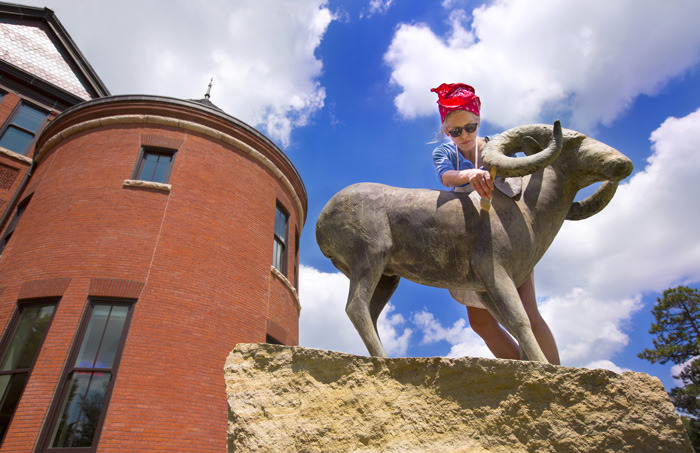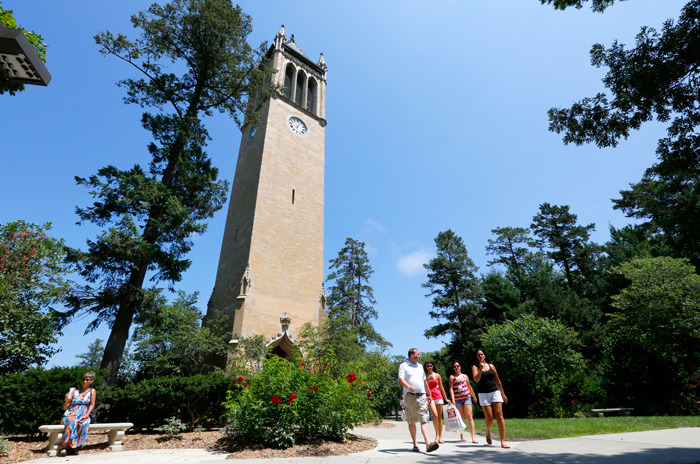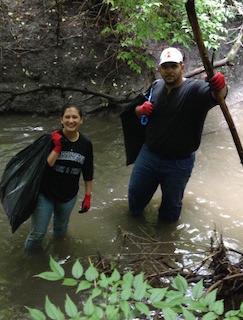Taking care of the animals

Photo by Christopher Gannon.
Kate Greder, campus outreach coordinator for university museums, took advantage of some great July weather last week to wax the seven bronze sculptures in artist Gwynn Murrill's A Walk on the Wild Side exhibition in the Anderson Sculpture Garden adjacent to Morrill Hall. She applied a light coating of wax, which she then buffed with a towel.
Greder said museums staff clean and wax outdoor sculptures two to three times a year to provide a protective layer against the elements and prevent corrosion. Faculty and staff who see art in their vicinity that needs some care and maintenance are asked to contact Greder. The more people on the lookout for conservation issues, the better, she said.
Iowa State's Art on Campus collection is one of the largest campus public art programs in the country -- more than 2,000 works of art, including about 50 outdoor sculptures. Routine care of all the pieces is critical to maintaining the collection, Greder said. Murrill's exhibition will be on display for another year.
Regents to consider spring tuition increase for resident undergrads
The state Board of Regents will discuss a 3 percent tuition increase for spring 2016 semester for resident undergraduate students when it meets via telephone next week. The increase would raise spring tuition $100 for most Iowa State resident undergraduates; up to $133 for programs with previously approved differential tuitions. If approved, it would raise an estimated $1.65 million in additional revenue for Iowa State. A final decision won't come until the board's Sept. 9 meeting.
Audio of the public portions of the Aug. 5 meeting (11 a.m.-2:30 p.m.) will be streamed live on the board's website. Initially scheduled to originate from the board office in Urbandale, the meeting has been moved to room 4, ground floor of the Scheman Building.
In December, the board approved a third straight tuition freeze for resident undergraduates, while approving increases ranging from 1.2 percent to 3.2 percent for all other students. The freeze anticipated the Legislature's support for the regents' proposed performance-based funding model, which didn't occur. In fact, new state dollars in the three public universities' operating budgets total about one-tenth what the increases were a year ago.
The diminished state appropriations, coupled with three years of frozen tuition for resident undergraduates – which make up just over half of ISU's student body – "puts a significant strain on education operating budgets," board staff noted.
If approved, the increase would reestablish base tuition for ISU's resident undergraduates at $6,848.
Student Innovation Center
Iowa State will seek the board's permission to select a design professional and proceed with planning for the Student Innovation Center, a proposed $80 million, 175,000-square-foot facility to be built south of Sweeney Hall. The site was selected for its proximity to undergraduate academic programs. The building will feature classrooms and flexible spaces that allow students to experiment, innovate and investigate across the academic disciplines.
The project will be funded equally by private gifts ($40 million) and state appropriations ($40 million over four years, FY17-20, approved by the 2015 Legislature).
To create space for the new building, the university will request permission to demolish the Nuclear Engineering Laboratory and the south portion of the original Sweeney Hall.
Cremation garden for ISU cemetery
Iowa State would like to sign a five-year agreement with the company Fans4Ever to design, construct and market a columbarium and garden adjacent to the east side of the university cemetery. A cremation garden responds to two needs: the alumni association has received requests from alumni and friends to bury cremated remains on campus, and, at the current interment rate, available spaces in the cemetery could be filled in five years. Rules about who may use the cremation garden will be set by the university; an early estimated cost per niche is around $6,000. The project would not proceed until there were enough presales to cover the development costs.
Facilities corporation
Iowa State leaders also will seek board permission to, in cooperation with the ISU Foundation, set up a nonprofit ISU Facilities Corporation to finance large building projects when cash funds or state appropriations are not available and the usual regent-issued bonds not appropriate for the project. Unlike the regents' academic revenue bonds or enterprise bonds, which use tuition and fees for service, respectively, to repay the debt, the facilities corporation bonds would use other sources – for example, private gifts or income from sponsored research – to pay off the bonds.
Senior vice president for business and finance Warren Madden said a facilities corporation is a funding vehicle that would give the university some flexibility to build and pay for large facilities, particularly those with a research focus. The corporation would own a building until the bonds are repaid, with the university as tenant and the board as lessee. The corporation's first bond issue, an estimated $20 million for the Advanced Teaching and Research Building, would occur in 2016.
The ISU Foundation's board approved the concept in June. The University of Iowa has had a facilities corporation since 1967 that has financed numerous research facilities on that campus.
Other requests
In other action, it's anticipated that the board will:
- Approve Iowa State's purchase of an Aberration-Corrected Scanning Transmission Electron Microscope ($3.66 million) for the nearly completed Sensitive Instrument Facility at the Applied Sciences Complex. Funding sources include university general funds, the College of Engineering and Ames Laboratory.
- Approve budgets for the fiscal year that began July 1. Iowa State's operating budget is a proposed $675 million; its total budget, including restricted funds and auxiliary units, is just under $1.4 billion.
- Approve a 20-year lease between the board and the ISU Research Park Corp. for about 17,000 square feet on the first and second floors of the 42,000-square-foot Hub Square Facility scheduled for completion next year. The research park will own the building and Iowa State will reimburse construction costs up to $12 million (the amount of the 2013 state appropriation for the facility and considered a prepaid base rent for the first 20 years.) Iowa State will pay its share of operating costs. Key ISU tenants include CyBiz, Pappajohn Center, Iowa Small Business Development Center, Office of Economic Development and Industry Relations, Center for Industrial Research and Service, Office of Intellectual Property and Technology Transfer and the ISU Research Foundation.
- Appoint Mark Braun, University of Iowa vice president for operational efficiency and regulatory analysis, as interim chief operating officer for the board of regents, effective Aug. 5. Braun served as the TIER (Transparent Inclusive Efficiency Review) project manager in the board office from August 2014 to April. Under a proposed change in organizational structure for the board staff, executive director Robert Donley would serve as the regents' chief executive officer. A chief academic officer and a chief operating officer would oversee separate functional areas but report to the executive director. Currently all staff report directly to Donley.
- Approve salaries for the fiscal year that began July 1 for heads of the regent institutions and Donley. Their performance evaluations were completed in June.
Blackboard technical support moves to Solution Center, expands hours
Under a new model for Blackboard instructor support, technical help is moving to information technology's Solution Center and will include evening and weekend service hours. The expanded services are effective Monday, Aug. 3.
Instructors will have five options to access Blackboard support:
- Contact the Center for Excellence in Learning and Teaching (CELT), which will continue to address questions that are pedagogical in nature, such as course design or instructional practices
- Visit www.it.iastate.edu/blackboard for links to common help topic articles, web-based help request forms and an RSS news feed
- Email solution@iastate.edu
- Phone the Solution Center at 294-4000
- Visit the Solution Center in 195 Durham Center
“This change will provide more accessible, comprehensive and on-demand technical support for faculty and students, and will allow the CELT staff to provide a broader scope of instructional support and faculty development services, aimed at promoting excellence in teaching and learning across campus," said Ann Marie VanDerZanden, CELT director.
"The Solution Center is excited to partner with CELT to provide technical support for Blackboard so that CELT may focus on instructional design and faculty pedagogical resources," said Mike Lohrbach, director of IT solutions, which includes the solution center.
Instructors should contact CELT for questions about developing new courses, effective strategies to engage students using Blackboard or other educational technologies, and other course design questions. The Solution Center will provide answers to faculty and students regarding technical issues, such as resetting passwords, enrolling students, assigning roles within the course, and storage or connectivity issues.
This new support model has been made possible through a collaborative development effort to build a comprehensive service that integrates CELT's knowledge base and the IT Solution Center's support structure. It comes just months after the Solution Center began offering Blackboard support to students.
Golden oldie

The campanile is a popular draw for both visitors to campus and locals. Photo by Christopher Gannon.
Zoom in on the Google maps version of Iowa State's central campus and you'll find "Golden Loop" labels on several sidewalks. The reference dates to the '90s, when university facilities and admissions staff created the semi-official tour route to showcase the beauty of campus.
Two decades later, Iowa State has grown considerably and moved well beyond a single iconic visitors' loop. Today, there are a variety of tour routes around campus, each tailored to prospective student and visitor interests and the time of year.
The phrase "Golden Loop" has disappeared almost everywhere but Google. The old loop is still around in spirit, however. Parents and students on admissions tours often follow paths that are quite similar to the old route. And facilities planning and management's campus services give the well-trod loop a little extra attention.
University employees looking for a pleasant walkabout over the noon hour or showing campus to visiting friends should enjoy this loop as well.
On the loop
The route essentially scoops the central campus loop and lawn south of the library, taking visitors (traveling clockwise) past Durham Center, Parks Library, The Hub, LeBaron Hall, MacKay Hall, Catt Hall, Curtiss Hall, the campanile, Memorial Union, Carver Hall, Enrollment Services, Pearson Hall and Marston Hall.
It's a .77 mile trip that hits many of the central university landmarks -- buildings, art, splendid plantings and charmingly knobby trees. For extra credit and mileage (.15 miles), visitors can do a small lap around the 118-year-old Marston water tower. Unfortunately, that tiny loop is presently off limits due to the Marston Hall remodeling.
Two teams, one clean creek
College Creek is looking especially good this summer, thanks to the recent kindly attention of nearly 80 volunteers.
It's the time of year when volunteers put on old shoes, grab trash bags and lend a hand at the College Creek cleanup. However, this year, the small creek got extra enhancement when students visiting campus as part of the College of Agriculture and Life Sciences' Carver Internship program waded in to assist.

Carver Interns Anya Priyanka Bonifaz and Zachary Brown took some time off from research activities to help clean College Creek. Photo by Arlyssia Sells.
The Carver interns got there first. Unable to attend the scheduled July 25 event, they hit the creek July 11. More than 40 volunteers, including 32 students, CALS administrators, professors and family members, tackled the portion of the stream that traverses the ISU cross country course, roughly from State Street to South Sheldon Avenue. Wading the creek and patrolling its banks, the crew picked up hundreds of pounds of trash ranging from bottles and metal fence posts to an 8-foot, 150-pound plastic drainage tube.
Last weekend, 36 volunteers focused on the portion of the creek that meanders through the southeast portion of campus, from the Memorial Union parking ramp to University Boulevard. The group netted several hundred more pounds of the usual trash (plastic bags, cans, bottles and hubcaps) and the more exotic (folding chair and hammer).
It's the seventh year for the College Creek cleanup, director of sustainability Merry Rankin said. The program was the brainchild of Shannon Sanders, a former political science student and intern in the Office of Sustainability's Live Green! program.
"What a wonderful difference this community-engaged and supported event makes," Rankin said of the annual program. "I'm so impressed with the volunteers who, year after year, come out to make our campus creek and its watershed cleaner."
The annual cleanup is sponsored by the Live Green! program and Keep Iowa State Beautiful campaign in partnership with facilities planning and management.
